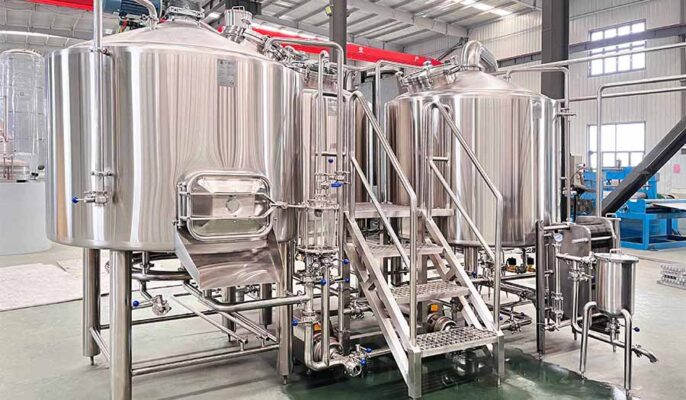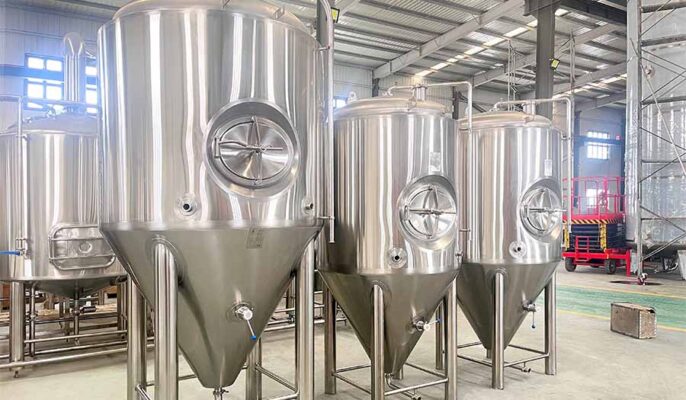The beer industry is favored by more and more brewers and beer lovers. With the development of the industry, the types of beer equipment are also rich and diverse. Equipment selection may vary based on the scale of production, the specific beer being produced, and the brewer’s preferences. With the rise of craft beer and microbreweries, the variety of equipment available has exploded to accommodate different brewing philosophies and techniques.
What is brewing equipment?
Brewing equipment refers to the machinery and tools used producing beer, cider, or any other fermented beverage. The process starts with raw materials such as barley, hops, water, and yeast and ends with the bottling or kegging of the final product. The quality, flavor, and characteristics of a beverage depend on the equipment used and the brewing method employed.
Basic components of brewing equipment:
- Grinding equipment: used to crush grains to ensure that the outer shell is intact and the interior is crushed.
- Mash barrel: A container in which crushed grains are mixed with water and heated. This process converts the starch in the grain into sugar.
- Pot: After mashing, the liquid is moved to the pot and boiled with hops to add flavor and aroma to the beer.
- Fermenter: After boiling, the liquid is cooled and transferred to the fermenter, where yeast is added. Yeast consumes sugar and produces alcohol and carbonic acid.
- Brite tanks: After fermentation, the beer is transferred to Brite tanks where it is clarified and carbonated before packaging.

What types of beer equipment are there?
The type and size of equipment may vary depending on the scale (home brewing vs. commercial brewing) and the specific beer being produced.
Home brewing equipment
- Brewing Kettle: A small stainless steel pot used to boil hop wort.
- Fermentation barrel: a plastic or glass container in which beer is fermented.
- Bottling bucket: used for adding base sugar and transferring beer to bottles.
All grain brewing equipment
- Mashing barrel: used to mix ground grains and water to promote the conversion of starch into sugar.
- Lauter Tun: Helps separate liquid wort from chaff.
Commercial Brewing Equipment
Brewery: a combined system including saccharification barrels, filter barrels, and brewing pots.
- Fermentation tank: Large tank for beer fermentation and maturation.
- Clear beer cans: Cans in which beer is clarified and carbonated before packaging.
Packaging Equipment
Once the beer is ready, it must be packaged for distribution.
- Bottling line: an automated system that fills, caps, and labels bottles.
- Kegging system: used to fill kegs for distribution to bars and restaurants.
Auxiliary equipment
The brewery also has some more equipment for various purposes.
- Heat exchanger: used to cool hot wort.
- Yeast propagation system: used to cultivate and store yeast.
- Quality Control Laboratory: Equipment used to test and ensure the quality of beer.
Brewing equipment price range:
| EQUIPMENT TYPE | PRICE RANGE (USD) |
| Homebrewing Kit | $50 – $300 |
| All-Grain Brewing Set | $200 – $1,500 |
| Commercial Fermentation Tank | $2,000 – $50,000 |
| Bottling Line | $10,000 – $250,000 |
| Quality Control Lab Equipment | $1,000 – $20,000 |
Brewery Equipment Application Types
The craft beer revolution has seen exponential growth in breweries around the world, each with its unique flavor profiles, brewing techniques, and target markets.
Nano brewery
Even smaller than microbreweries, nanobreweries often start as hobby projects and later develop into commercial endeavors. Their batch yield may only be one barrel. The equipment used here is a step above home brewing kits but retains the spirit of grassroots brewing.

Microbrewery
Microbreweries produce less than 15,000 barrels of beer per year. They focus on quality, flavor, and brewing techniques over mass distribution. Professional brewing equipment tailored for small breweries often focuses on flexibility, allowing brewers to experiment with different beer styles.
Home brew beer bar
A brewpub is a hybrid of a brewery and a bar, where beer is brewed on-site and served with food. Equipment in these environments is often visible to customers, emphasizing the freshness of the beer. The equipment is smaller in size than larger breweries but is designed for more frequent brewing cycles due to its direct-to-consumer model.
Regional breweries
Regional breweries serve a larger area, usually an entire country or many states. Their facilities are larger and focus on consistency and efficiency. With an annual production capacity of 15,000 to 6 million barrels, brewing equipment needs to meet a huge demand.
Commercial brewery
Commercial breweries are giants in the beer world, producing over 6 million barrels per year. Their facility is industrial scale, with huge fermentation tanks, advanced automation equipment, and advanced quality control systems.
Professional and experimental breweries
These businesses focus on creating unique, often limited-edition beers. Think beers with non-traditional ingredients like fruit, spices, and even coffee. Brewing equipment in this type of setup often includes extra vessels or machinery to handle these ingredients.
What are the functions of professional brewing equipment?
- Mashing Equipment: The main goal of the mashing process is to convert the starch in the malted grains into fermentable sugars. This process requires maintaining a specific temperature to activate the enzyme. The device ensures that these conditions are met and maintained.
- Boil and Whirlpool Equipment: Boiling wort serves a variety of purposes – it sterilizes the wort, extracts flavor and bitterness from the hops, and evaporates unwanted volatile compounds. After boiling, the vortex function helps separate hop residue and other solids from the wort.
- Fermentation Equipment: This is where the magic happens. Yeast is introduced into the cooled wort, converting the sugar into alcohol and carbon dioxide. Fermenters maintain a controlled environment that allows the yeast to function . They also provide a sealed environment that prevents contamination from external microorganisms.
- Cooling and Temperature Control: Cooling the wort after boiling is essential to prevent unwanted bacterial growth. Additionally, fermentation is a temperature-sensitive process; too hot or too cold can affect the flavor of your beer. The cooling system ensures consistent temperatures throughout.
- Packaging Equipment: Once the beer is fermented and matured, it is ready for distribution. Packaging equipment ensures that beer is transferred to bottles or kegs without introducing oxygen, which can spoil the beer. The automated system also ensures consistent volumes, carbonation levels, and efficient labeling for large-scale dispensing.
How to choose beer equipment?
- Determine your size: The first step is to determine how big you plan to brew. A home brewery may need equipment that can handle 5-10 gallons, while a commercial brewery may need a system that can handle hundreds or thousands of gallons.
- Budget: Investments in brewing equipment range from a few dollars to millions of dollars. Create a clear budget that takes into account not only the initial buy, but also maintenance, upgrades, and potential expansions.
- Research brands and reviews: Several brands produce brewing equipment, and each brand has its pros and cons. Research , read reviews, and even visit some local breweries to see the equipment in action.
- Features and Technology: Modern brewing equipment can be equipped with many features – automatic controls, digital displays, built-in cleaning systems, and more. Determine which features are essential to your brewing style and which can be dispensed with.
- Materials and build quality: Brewing equipment, especially for commercial use, should be sturdy and durable. Stainless steel is preferred because it resists corrosion, is easy to clean, and has a long lifespan.
- Space considerations: Make sure you have enough space to house and operate your brewing equipment. Consider aspects such as ventilation, drainage, and accessibility.
Product advantages of Chinese brewing equipment
Chinese brewing equipment has taken the global market by storm, thanks to China’s emphasis on innovation, quality, and cost-effective solutions.
- Cost-Effectiveness: Chinese manufacturing processes combined with economies of scale can produce high-quality equipment at competitive prices.
- Quality and Innovation: Contrary to some stereotypes, many Chinese manufacturers focus on quality and innovation. They produce equipment that rivals, if not surpasses, their Western counterparts.
- Customization services: Chinese manufacturers often offer a wide range of customization options, such as Chinese manufacturer Micet. This flexibility ensures the equipment fits the brewery’s specific needs and vision.
- Fast production delivery: Chinese manufacturers can produce and ship equipment faster, reducing wait times.
- Variety: From home brewing kits to large-scale commercial systems, Chinese manufacturers offer a variety of products to suit every size and brewing style.




